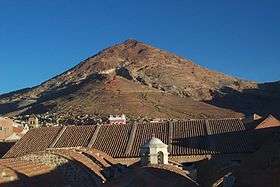Cerro Rico
| Cerro Rico | |
|---|---|
| Cerro Potosí / Sumaq Urqu | |
 View of Cerro Rico from Potosí | |
| Highest point | |
| Elevation | 4,782 m (15,689 ft) |
| Coordinates | 19°37′8″S 65°44′59″W / 19.61889°S 65.74972°WCoordinates: 19°37′8″S 65°44′59″W / 19.61889°S 65.74972°W |
| Geography | |
 Cerro Rico Location in Bolivia | |
| Location | Bolivia, Potosí |
| Parent range | Andes |
Cerro Rico (Spanish for "rich mountain"), Cerro Potosí[1] ("Potosí mountain") or Sumaq Urqu[2] (Quechua sumaq beautiful, good, pleasant, urqu mountain,[3] "beautiful (good or pleasant) mountain") is a mountain in the Andes near the Bolivian city of Potosí. Cerro Rico was famous for providing vast quantities of silver for Spain during the period of the New World Spanish Empire. The mountain, which is popularly conceived of as being "made of" silver ore, caused the city of Potosí to become one of the largest cities in the New World. After 1800, the silver mines were depleted, making tin the main product. This eventually led to a slow economic decline. Nevertheless, the mountain continues to be mined for silver to this day. Due to poor worker conditions, such as a lack of protective equipment against the constant inhalation of dust, many of the miners contract silicosis and have a life expectancy of around 40 years. The mountain is still a significant contributor to the city's economy, employing some 15,000 miners.
It is known as 'mountain that eats men' because of the large number of workers who died in the mines. Some writers such as Eduardo Galeano in his work Open Veins of Latin America estimate, quoting Josiah Conder,[4] that up to 8 million men have died in the Cerro Rico since the 16th century. Historians such as Peter Bakewell,[5] Noble David Cook,[6] Enrique Tandeter [7] and Raquel Gil Montero [8] take a different and more academic approach to the issue.
As a result of centuries long mining, in 2011 a sinkhole in the top appeared and had to be filled with ultra-light cement. The summit also continues to sink a few centimetres every year.[9] In 2014, UNESCO added Cerro Rico and Potosí to its list of endangered sites, owing to "uncontrolled mining operations" that risk "degrading the site".
Mine
The Cerro Rico de Potosí mine is one of the largest silver mines in Bolivia and in the world.[10] The mine is located in the south of the country in Potosí Department.[10] The mine has estimated reserves of 1.76 billion oz of silver and 540 million tonnes of ore grading 0.17% tin.[10]
See also
References
- ↑ Bolivian IGM map 1:50,000 Potosí (Oeste) 6435-III
- ↑ Roberto Choque Canqui, Jesús de Machaqa, La marka rebelde, Cinco siglos de historia, Cuadernos de Investigación 45, La Paz, Bolivia, 2003
- ↑ Teofilo Laime Ajacopa, Diccionario Bilingüe Iskay simipi yuyayk'ancha, La Paz, 2007 (Quechua-Spanish dictionary)
- ↑ "Modern Traveler". London: J.Duncan. 1830.
- ↑ Bakewell, Peter "Miners of the Red Mountain: Indian Labor in Potosi, 1545-1650". University of New Mexico Press 2010"
- ↑ Demographic Collapse: Indian Peru, 1520-1620 (Cambridge Latin American Studies)
- ↑ Tandeter, Enrique. "Coaccion y mercado. La mineria de plata en el Potosi colonial, 1692-1826". Siglo XXI Editores 2001.
- ↑ "Free and Unfree Labour in the Colonial Andes". Instituto Superior de Estudios Sociales (CONICET-UNT), Tucuman. 2011.
- ↑ http://www.theguardian.com/world/2014/jan/10/bolivia-cerro-rico-mountain-sink-city-potosi
- 1 2 3 "Metallogeny of Bolivia" (PDF). uchile.cl. 2013. Retrieved 2013-07-21.